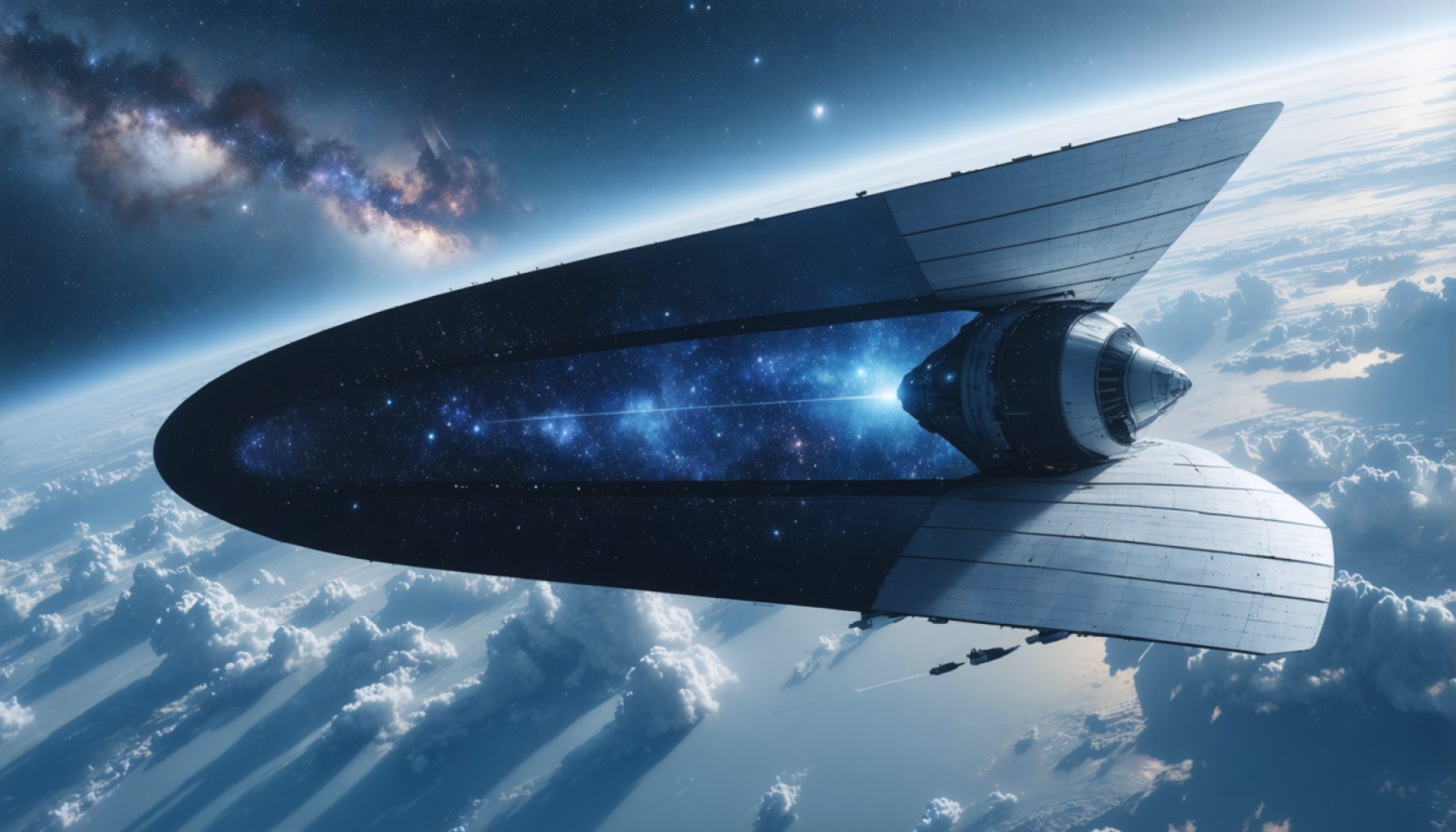- Voyager 1 underscores the need for advanced space travel, highlighting the potential of lightsails for interstellar exploration.
- Lightsails utilize photon momentum instead of traditional fuel, offering a sustainable propulsion method.
- A silicon nitride lightsail, only 200 nanometers thick, has been developed with precision engineering and AI assistance.
- Produced rapidly using TU Delft’s etching techniques, this lightsail represents a significant shift in interstellar travel feasibility.
- The Starshot Breakthrough Initiative envisions large laser-powered sails carrying microchip-sized explorers to neighboring star systems like Alpha Centauri.
- This advancement could drive innovation in nanoscale engineering and machine learning, solving complex engineering challenges.
- The promise of lightsails proposes a new era of reaching galaxies once restricted to dreams.
Voyager 1, NASA’s enduring cosmic pioneer, has spent decades etching its path through the vast expanse of space, yet even its impressive journey fails to scratch the celestial neighborhood beyond our solar system. Moving at a snail’s pace relative to the universe’s grandeur, it highlights an urgent need for a revolutionary leap in space travel—one that might be found in the shimmering promise of lightsails.
Imagine a delicate sheet, thinner than a butterfly’s wing and more reflective than a mirror on a sunlit day, harnessing the sheer power of light to traverse the stars. This is the promise encapsulated within the light-driven propulsion: lightsails, which exploit the momentum of photons in place of traditional fuel, offering a sustainable pathway to the stars. The physical world as we know it may soon be redrawn with the help of cutting-edge collaborations stemming from academic powerhouses like Brown University and Delft University of Technology (TU Delft).
Engineers and scientists have converged upon a feat of brilliance, birthing a prototype spearheading this luminous revolution. Crafted from silicon nitride, the new lightsail is a mere 200 nanometers thick and just shy of the size of a business card. More than a technological marvel, it’s a symphony of meticulous engineering, perfected to harness the sun’s energy. This super-reflective sail solves an intricate dance of precision, as engineers meticulously arranged billions of microscopic holes using the wisdom derived from artificial intelligence.
The ingenuity here is more than just theoretical—it’s a testament to modern manufacturing prowess. Through TU Delft’s pioneering etching techniques, the sail becomes reality in just a single day, highlighting its robustness against the rugged vacuums of space. This method, reducing time and costs dramatically, underscores a pivotal shift in the feasibility of interstellar exploration.
While the vision for lightsail-driven spacecraft might seem like an optimistic aspiration, it resonates with the ethos of the Starshot Breakthrough Initiative. Picture this: laser-powered sails, vast enough to encompass entire football fields, each leaping through space with microchip-sized explorers nestled within them. They could eventually transform the science fiction of reaching Alpha Centauri—a neighboring star system—into a scientific milestone.
More than a leap toward the stars, these advancements could herald a broader age of innovation in nanoscale engineering and machine learning. Applying this intelligent synthesis could unlock solutions to seemingly insurmountable engineering challenges that have long vexed scientists.
As humanity gazes skyward, longing for the galaxies sitting tantalizingly beyond reach, the shimmering promise of lightsails invites us to dream bigger. In the timeless dance between light and matter, we find not just aspiration but tangible potential. We stand on the cusp of an era where these flickers of innovation might just lead us to galaxies we’ve only dreamed of reaching.
Lightsails: The Future of Sustainable Space Travel Unveiled
Understanding the Promise of Lightsails
Lightsails, a groundbreaking innovation in space exploration, are capturing the imagination of scientists and engineers. They offer a sustainable, fuel-free method of travel powered entirely by light—specifically, the momentum of photons. The new prototype lightsail, developed through collaboration between Brown University and Delft University of Technology, is a marvel of modern engineering, crafted from silicon nitride and fine-tuned using artificial intelligence.
How Lightsails Work
The concept of lightsails revolves around the science of photonic propulsion, where photons from a light source, such as the Sun or a high-powered laser, impart momentum upon striking the reflective sail. This method eliminates the need for traditional chemical propellants, significantly reducing the weight and costs of space missions.
Real-World Use Cases
Lightsails hold the potential to revolutionize multiple domains within space exploration:
– Deep Space Exploration: Missions to distant star systems, like Alpha Centauri, could become feasible within a human lifetime.
– Satellite Maneuvering: Lightsails can provide efficient station-keeping and orbital adjustments for satellites.
– Space Debris Mitigation: By deploying lightsails on defunct satellites, we can guide them to burn up during re-entry into Earth’s atmosphere.
Industry Trends and Market Forecasts
The space exploration industry is projected to witness a surge in investments towards light-driven technologies. Initiatives like the Starshot Breakthrough Initiative are paving the way for future growth. According to the Global Space Propulsion System Market report, there’s an expected compound annual growth rate (CAGR) in the propulsion systems sector, driven by advancements like lightsails.
Pros and Cons Overview
Pros:
– Sustainability: No chemical fuel required, reducing environmental and financial costs.
– Infinite “Fuel” Supply: As long as there’s light, propulsion is possible.
– Lightweight Design: Enables more payload capacity for scientific instruments and exploratory equipment.
Cons:
– Initial Velocity Requirement: Requires significant initial energy input to start the journey.
– Vulnerability in Space: Potential damage from micro-meteoroids and space debris.
– Technological Maturity: Still in the experimental phase with full-scale missions pending.
Reviews and Comparisons
Lightsails are often compared to other emerging propulsion technologies like ion thrusters and nuclear thermal propulsion. While each has its merits, lightsails stand out for their sustainability and low operational costs. However, the thrust level achievable with lightsails is considerably lower, making them more suited for long-duration missions.
Pressing Questions and Answers
How feasible is traveling to other star systems using lightsails?
The Starshot Breakthrough Initiative envisions reaching Alpha Centauri within twenty years of launch. However, this depends on continued technological advancements and financial investments.
Can lightsails be integrated with existing spacecraft technologies?
Yes, integrating lightsails with miniaturized spacecraft technologies like CubeSats is a current area of research. This synergy could revolutionize low-cost, high-impact space exploration missions.
What materials are ideal for constructing lightsails?
Materials with high reflectivity and low atomic mass, like metallic films or dielectric layers, are ideal. Researchers are also exploring graphene and other advanced materials.
Actionable Recommendations
1. Stay Informed: Follow updates from institutions like NASA and the Delft University of Technology for the latest breakthroughs in lightsail technology.
2. Engage with Community: Participate in forums and discussions related to space exploration to keep abreast of emerging trends and technologies.
3. Support Research Initiatives: Contribute to crowdfunding campaigns or support academic projects that aim to accelerate the development of lightsail technology.
As the potential for tapping into light as a source of propulsion becomes a reality, humanity stands on the brink of a new era in space exploration. The dreams of reaching new worlds may soon be within our grasp, thanks to the shimmering promise of lightsails.













